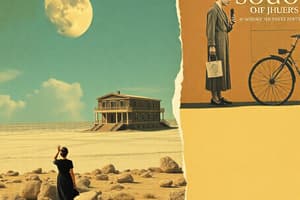Podcast
Questions and Answers
What does filmmaking primarily involve?
What does filmmaking primarily involve?
- Just the filming process
- Writing reviews about movies
- Only the editing phase of a movie
- Creating a film from start to finish (correct)
Which of these activities happens during pre-production?
Which of these activities happens during pre-production?
- Casting the actors (correct)
- Composing the musical score
- Editing the footage
- Adding visual effects
What is the purpose of storyboards in filmmaking?
What is the purpose of storyboards in filmmaking?
- To plan the budget
- To design the costumes
- To depict each shot visually (correct)
- To record the dialogue
Which of these tasks is part of the 'production' phase?
Which of these tasks is part of the 'production' phase?
What does a cinematographer primarily focus on?
What does a cinematographer primarily focus on?
Which of these activities occurs during post-production?
Which of these activities occurs during post-production?
What is the role of the director?
What is the role of the director?
What is the main responsibility of a producer?
What is the main responsibility of a producer?
What is the editor responsible for?
What is the editor responsible for?
Which film genre is designed to be humorous?
Which film genre is designed to be humorous?
What is the purpose of a 'cut' in editing?
What is the purpose of a 'cut' in editing?
Which sound design element refers to spoken words in a film?
Which sound design element refers to spoken words in a film?
What does the Auteur Theory suggest?
What does the Auteur Theory suggest?
Which film movement is known for its realistic stories and non-professional actors?
Which film movement is known for its realistic stories and non-professional actors?
What is the purpose of a tripod?
What is the purpose of a tripod?
Which distribution method involves releasing a film in cinemas?
Which distribution method involves releasing a film in cinemas?
Selling distribution rights in advance to raise funds is known as what?
Selling distribution rights in advance to raise funds is known as what?
What is 'Foley' in the context of sound design?
What is 'Foley' in the context of sound design?
Which of these camera movements involves moving the camera horizontally?
Which of these camera movements involves moving the camera horizontally?
What is parallel editing?
What is parallel editing?
Flashcards
Filmmaking
Filmmaking
The entire process of creating a film, from the initial idea to final distribution.
Pre-Production
Pre-Production
Planning stage involving story development, scriptwriting, casting, location scouting and budgeting.
Storyboards
Storyboards
Creating drawings or images depicting each shot in the film, helping to visualize the narrative.
Production
Production
The actual filming phase where the script is brought to life.
Signup and view all the flashcards
Cinematography
Cinematography
Capturing the visual elements of the film using cameras and lighting.
Signup and view all the flashcards
Post-Production
Post-Production
Assembling and refining the raw footage and sound into a finished film.
Signup and view all the flashcards
Editing
Editing
Reviewing, selecting, and assembling footage into the final cut of the film.
Signup and view all the flashcards
Visual Effects (VFX)
Visual Effects (VFX)
Enhancing or creating elements not captured during filming using digital and visual tools.
Signup and view all the flashcards
Director's role
Director's role
Director is the primary creative force behind the film.
Signup and view all the flashcards
Producer's Role
Producer's Role
That role manages the business and logistical aspects of filmmaking.
Signup and view all the flashcards
Cinematographer's Role
Cinematographer's Role
The person responsible for the visual look of the film, including lighting and camera angles.
Signup and view all the flashcards
Editor's Role
Editor's Role
Assembles the raw footage into the final cut of the film.
Signup and view all the flashcards
Action films
Action films
Films featuring intense combats, stunts, chases, and violence.
Signup and view all the flashcards
Comedy films
Comedy films
Films designed to be humorous.
Signup and view all the flashcards
Horror films
Horror films
Films designed to scare or frighten the audience.
Signup and view all the flashcards
Shot Composition
Shot Composition
Arrangement of visual elements within a frame.
Signup and view all the flashcards
Lighting (film)
Lighting (film)
Use light to create mood, atmosphere, and visual interest.
Signup and view all the flashcards
Cut (editing)
Cut (editing)
Instant transition from one shot to another.
Signup and view all the flashcards
Music (film)
Music (film)
The musical score of a film enhances the atmosphere and emotion.
Signup and view all the flashcards
Auteur Theory
Auteur Theory
The director is seen as the primary creative force behind a film.
Signup and view all the flashcardsStudy Notes
- Filmmaking is the process of creating a film, involving numerous complex and interconnected stages.
- It encompasses everything from the initial story conception to the final distribution of the completed movie.
Pre-Production
- Pre-production involves planning and preparation before shooting begins.
- Idea Development: This is the initial stage where the concept for the film is created, refined, and developed into a workable story.
- Scriptwriting: A script, or screenplay, is written, detailing the story, dialogue, and action.
- Storyboards: Storyboards consist of drawings or images depicting each shot in the film, helping to visualize the narrative.
- Casting: Actors are selected to play the various roles in the film.
- Location Scouting: Suitable locations for filming are identified and secured.
- Budgeting: A detailed budget is created to estimate the costs of production.
- Scheduling: A production schedule is established, outlining when each scene will be shot and what resources will be needed.
Production
- Production is the actual filming phase, where the script is brought to life.
- Cinematography: Cinematography involves capturing the visual elements of the film using cameras and lighting.
- Sound Recording: Dialogue, sound effects, and ambient noise are recorded during filming.
- Directing: The director oversees all aspects of the production, guiding the actors and crew to realize their vision.
- Set Design: The sets are constructed and decorated to create the appropriate environment for each scene.
- Costume Design: Costumes are designed and created to reflect the characters' personalities and the film's setting.
Post-Production
- Post-production involves assembling and refining the raw footage and sound into a finished film.
- Editing: The footage is reviewed, selected, and assembled into the final cut of the film.
- Sound Design: Sound effects, music, and dialogue are mixed and enhanced to create the film's soundtrack.
- Visual Effects (VFX): Visual effects are added to enhance or create elements that were not captured during filming.
- Color Correction: The colors in the film are adjusted to create a consistent look and feel.
- Music Composition: A score is composed and recorded to enhance the emotional impact of the film.
- Distribution: The completed film is distributed to theaters, streaming services, and other outlets.
- Marketing: The film is promoted to audiences through trailers, posters, and other marketing materials.
Key Roles in Filmmaking
- Director: The director is the primary creative force behind the film, responsible for overseeing all aspects of production.
- Producer: The producer manages the business and logistical aspects of filmmaking, including budgeting, scheduling, and hiring.
- Cinematographer: The cinematographer is responsible for the visual look of the film, including camera angles, lighting, and composition.
- Editor: The editor assembles the raw footage into the final cut of the film, making decisions about pacing, rhythm, and storytelling.
- Production Designer: The production designer oversees the visual design of the film, including sets, costumes, and props.
- Screenwriter: The screenwriter writes the script, which provides the foundation for the film's story, characters, and dialogue.
- Composer: The composer writes the musical score, which enhances the emotional impact of the film.
Film Genres
- Action: Films featuring intense sequences, stunts, chases, and violence.
- Comedy: Films designed to be humorous.
- Drama: Films focusing on character development and conflict.
- Horror: Films designed to scare or frighten the audience.
- Science Fiction: Films featuring futuristic technology, space exploration, or other science-based themes.
- Fantasy: Films featuring magic, mythical creatures, or supernatural elements.
- Thriller: Films designed to create suspense and excitement.
- Documentary: Films presenting factual information about real-world subjects.
- Animation: Films created using animated images, such as cartoons or CGI.
- Historical: Films that are set in the past and often recreate historical events or portray the lives of past figures.
Cinematography Techniques
- Shot Composition: The arrangement of visual elements within a frame.
- Camera Movement: The use of camera movement to create different effects e.g. panning, tilting, zooming, tracking.
- Lighting: The use of light to create mood, atmosphere, and visual interest.
- Color: The use of color to evoke emotions or convey meaning.
- Focus: The adjustment of focus to draw attention to certain elements in the frame.
Editing Techniques
- Cut: An instantaneous transition from one shot to another.
- Fade: A gradual transition from one shot to black or from black to a shot.
- Dissolve: A gradual transition from one shot to another, where the two shots overlap.
- Montage: A sequence of shots edited together to condense time or convey a particular idea.
- Parallel Editing: Cutting between two or more scenes happening simultaneously to create suspense.
Sound Design Elements
- Dialogue: Spoken words in a film.
- Sound Effects: Artificially created or enhanced sounds to enhance the film's realism.
- Music: The musical score of a film, which is used to enhance the atmosphere and emotion.
- Ambient Sound: Background noise that establishes the setting.
- Foley: The reproduction of everyday sound effects that are added to film in post-production to enhance audio quality.
Film Theory
- Auteur Theory: The director is viewed as the primary creative force behind a film, imbuing it with their personal vision.
- Genre Theory: Suggests that films can be organized and understood based on recurring conventions, themes, and iconographies.
- Feminist Film Theory: Examines gender representation in film and challenges patriarchal structures.
- Marxist Film Theory: Analyzes film in terms of class struggle and ideological power.
- Semiotics: The study of signs and symbols and their interpretation in film.
Film Movements
- Italian Neorealism: A post-World War II film movement characterized by realistic stories, non-professional actors, and location shooting.
- French New Wave: A French film movement of the late 1950s and 1960s characterized by experimental techniques and personal expression.
- New Hollywood: A period in American cinema from the late 1960s to the early 1980s characterized by innovative storytelling and auteur directors.
- Dogme 95: A Danish film movement that sought to strip away artifice and focus on realism in filmmaking.
Key Equipment
- Camera: Used to capture images.
- Lenses: Used to control the field of view and depth of field.
- Lighting: Used to illuminate the scene and create mood.
- Microphones: Used to record sound.
- Tripods: Used to stabilize the camera.
- Editing Software: Used to assemble and manipulate footage.
- Sound Recording Equipment: Used to capture and mix audio.
Distribution Methods
- Theatrical Release: Releasing the film in cinemas.
- Film Festivals: Showcasing films at festivals to gain attention and distribution deals.
- Streaming Services: Licensing the film to streaming services like Netflix, Amazon Prime Video, or Hulu.
- DVD/Blu-ray: Selling physical copies of the film.
- Television Broadcast: Licensing the film to television networks.
- Online Sales and Rentals: Selling or renting the film through digital platforms.
Film Funding
- Studio Funding: Major film studios provide funding for large-budget productions.
- Independent Funding: Independent filmmakers rely on private investors, grants, and crowdfunding.
- Government Subsidies: Government agencies provide funding to support film production.
- Co-productions: Multiple production companies from different countries pool resources to finance a film.
- Presales: Selling distribution rights in advance to raise funds for production.
Studying That Suits You
Use AI to generate personalized quizzes and flashcards to suit your learning preferences.




